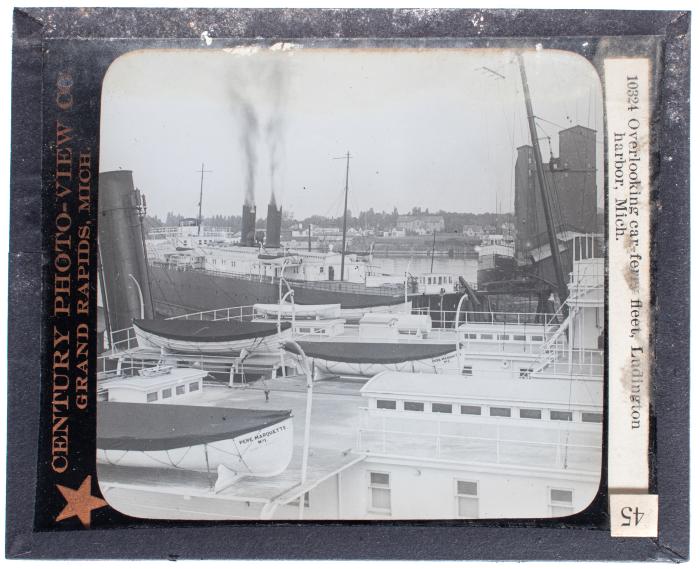Photographs
Magic Lantern Slides
Magic Lantern Slideshow - Michigan Views ➔ Lantern Slide, Overlooking Car Ferry Fleet
Identifier:
2021.6.6.69Date:
1919 – 1950Materials:
GlassDimensions:
4" h 3.25" wCurrent Location Status:
In StorageCollection Tier:
Tier 2Related Entities:
Century Photo-View Company (creator)Century Photo-View Company was spread between Midland, Saginaw, Grand Rapids, and Traverse City, Michigan with both stereograph publishers and photographers. The first known entity was established ca 1904 as the Midland Stereograph Publishers. The photography company was in Grand Rapids from 1919 - 1930.
The Midland, Saginaw and Traverse City stereograph imprints seem to have been used interchangeably and simultaneously, rather than sequentially. The Midland imprint was used on stereo views of Midland, of the 1904 funeral of Perry Hannah and other scenes at Traverse City, and of Mackinac Island, St. Charles, St. Ignace, Sault Ste. Marie, Ishpeming, Marquette, Negaunee and Frankfort; also of the Louisiana Purchase Exposition at St. Louis in 1904, Park Place in New York City, and of humorous and sentimental subjects. The Saginaw label appeared on stereo views of Davison, Flushing, St. Ignace, Saginaw, Durand and humorous subjects. Traverse City stereographs included views of Harbor Springs, Harbor Point, Charlevoix, Petoskey, Traverse City, Mackinac Island and sentimental subjects as well as views of Arizona, California, Colorado and Missouri. “Published by Century Photo-View Co., Traverse City, Mich.” was printed on the post card backs of photographs with legends printed on their negatives in small block letters. Besides views of Traverse City, these included scenes at Crystal Lake, Frankfort, South Frankfort and Thompsonville in Benzie County, and at Mesick in Wexford County. Many of these cards were postmarked during 1910. Cards with the same type of printed legends but without the back mark were common, and included views of a Knights of Pythias conclave at Traverse City on October 21, 1906, a Soldiers’ Encampment there in September of 1907, and the decorations on Front Street for July 4, 1908.
In 1922 it was educational, religious and advertising slides, projection equipment and theatre supplies. “CENTURY PHOTO-VIEW CO., TRAVERSE CITY, MICH.” or “CENTURY PHOTO-VIEW CO., GRAND RAPIDS, MICH.” was printed in gold on the black border surrounding the photographs of lantern slides. Some of these slides depicted birds, an excelsior plant, a cooperage plant, assembling barrels, a veneer mill, a shingle mill, a saw mill, tanbark outside a tannery, Michigan white pine - cut and burned, a log drive on the Betsie River, a banking ground, a lumber yard at Traverse City, the Piqua Handle Works at Thompsonville, and a poor farmer’s homestead in Kentucky. Numbered views included 25c - A jam during a log drive on the Betsie River, 26a - Saw mill, boom of logs and lumber piles on the Saginaw River, 26d - Loading steam barge with lumber at Empire, 10313 - Wood yard and charcoalchemical plant at Cadillac, 10513 - Rollways at Boardman Lake in Traverse City, and 10521 - Trainload of hard wood. Some of the views were nicely hand-colored. “Century Photo-View Co., Grand Rapids, Mich.” was printed on the postcard backs of photographs postmarked from 1923 to 1926, and was stamped on the backs of others along with “Sample Card, No. _____” Descriptions were printed on the cards in various styles, usually on the face at the top or beneath the picture, of scenes in Kent, Leelanau, Newaygo and Osceola Counties.
Grand Rapids Public Museum (used by)
Alternate names: Grand Rapids Lyceum of Natural History, Grand Rapids Scientific Club, GRPM, Kent Scientific Institute, Kent Scientific Museum, Public Museum of Grand Rapids, Public Museum of West Michigan
The Grand Rapids Lyceum of Natural History was established in 1854 by a group of civic leaders, inspired by a movement sweeping the country. Followers of the Lyceum Movement believed that education, in the form of libraries, museums, lectures and discussions, and public schools, could help right the illnesses of society and preserve democracy.
In the early 1860s the Civil War had put a halt to the activities of the Lyceum. But in the summer of 1865, the war was over, and the enthusiasm of a group of teenage boys for new ideas about science and nature would bring the fledgling Museum back to life.
In 1868 the Grand Rapids Lyceum of Natural History and the Grand Rapids Scientific Club merged to form the Kent Scientific Institute. The new organization successfully combined the youthful enthusiasm of local high school students with the experience of prominent civic leaders to create a successful museum for their community.
In 1881, the Kent Scientific Institute reached an agreement with the Board of Education which allowed them to store their collections at Central High School.
In February of 1903, the Board of Education agreed to purchase the Howlett House, at the corner of Jefferson and Washington, to be the permanent home of the Kent Scientific Institute.
The "new" Grand Rapids Public Museum was built during the Great Depression with WPA funds from the Federal Government. The building itself was a radical departure from most contemporary museums, and was described by Museum Director Frank DuMond as "accessible as a dime store and friendly as your next door neighbor."
The Grand Rapids Public Museum began experimenting with planetarium equipment in the early 1960s, and hired its first curator for the new technology in 1964. The planetarium was eventually named after Grand Rapids astronaut Roger B. Chaffee, who was killed in the Apollo I disaster on January 27, 1967.
In 1989, the Grand Rapids Public Museum took over the management of the Voigt House in the Heritage Hill Neighborhood. The opulent home was built in 1895 and includes more than 100 years of the Voigt family's possessions.
The Grand Rapids Public Museum's current facility opened in 1994 on the west bank of the Grand River in the heart of downtown. It contains three floors of exhibits, the Roger B. Chaffee Planetarium, the Cook Carousel Pavilion, Meijer Theater, cafe, and gift shop.

